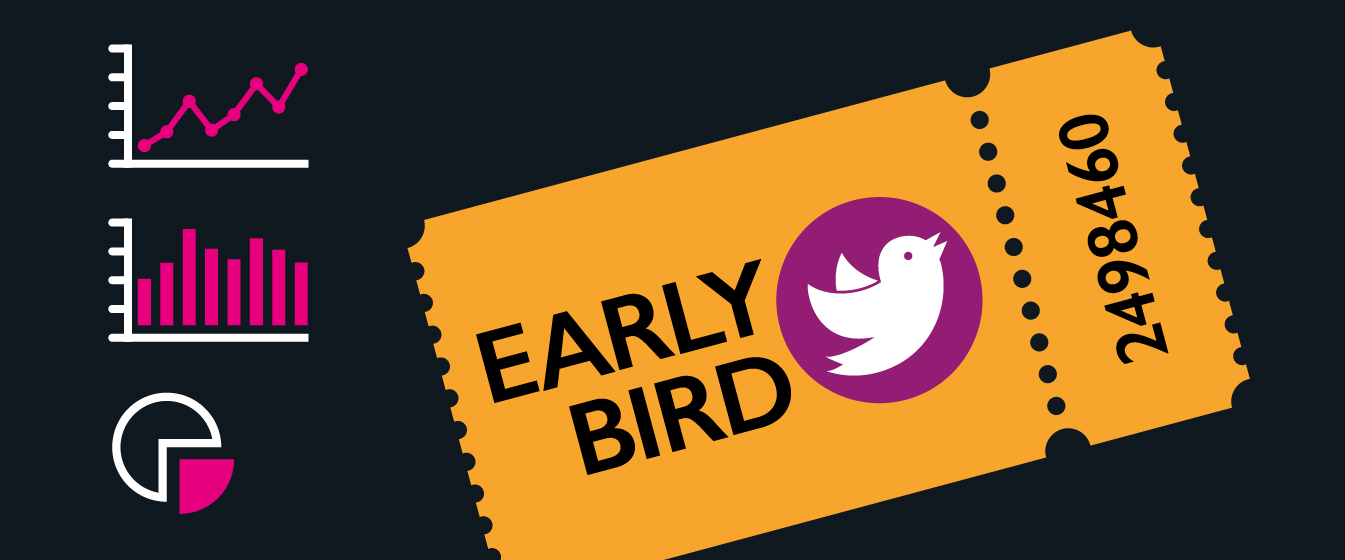Blog: Event management
More than just marketing: unlocking insights from early bird registrations
1 July 2025 minute read

We’ve all heard the cliché about how the early bird catches the worm.
And that’s how most planners think of the early bird discount: simply as a means to incentivise people to sign-up early, by offering them a juicy discount or added value.
But have you heard the one about how the organiser who deploys early bird discounting catches actionable intelligence about purchase intent that can be leveraged to adjust your event offer and optimise registrations and revenue?
Yeah, they don’t tend to put that one on tea towels, but maybe they should, since it’s where the real value of an early bird strategy lies.
Because early bird discounting extends far beyond just front-loading momentum in ticket sales. Used intelligently, early bird registration can help reduce planning risk, accelerate pipeline generation, and deliver crucial insights that inform campaign targeting, resource allocation, and sales alignment.
Yet, lots of planners still see it only in terms of creating a sense of urgency and FOMO, overlooking how early registration can drive smarter decision-making across your entire events operation.
Here are some ways you can transform early bird registration from just another marketing tactic, to a rich source of forecasting and strategic insight.
Leverage the data
Early bird registration data represents a powerful early signal as to who’s engaging with your content, which verticals or regions are converting and which personas are responding to your campaigns.
Used strategically, this data allows marketing, sales, and event operations teams to make faster, smarter decisions across the planning cycle.
When you think about it, early bird registration gives you pretty much real-time visibility into your future audience by job-title, industry, company size, and demography.
Analyse this data as it comes in and your team will be in a position to prioritise sessions and tracks with the highest demand; allocate budget towards specific translation or localisation demands; adjust the format of networking events based on the mix of verticals or OEMs vs suppliers, and much more besides.
For example, say your early bird data shows a spike in uptake from German-based purchasing managers. Armed with this information, your content team can prioritise sessions on purchasing challenges and make sure German subtitles are available.
In other words, early bird registration is more than just a reporting metric. It’s a major planning input.
For corporate conferences and sales events, matching early bird registrations to your Account Based Marketing data can indicate how well campaigns are landing with your key accounts. If Tier 1 coverage looks light, the sales team can step in early with targeted outreach or personal invites from senior executives.
Let’s say a field marketing team notices strong sign-ups from the Northwest region but lower engagement from strategic APAC accounts. When caught early enough, this kind of insight can inform nimble campaign pivots, sales activation, or even investment in new speakers or content to improve performance in the weaker regions.

Tiered pricing and incentives
In the enterprise event space, early bird pricing is less about giving discounts and more about intentionally shaping event attendance. Tiered pricing structures and targeted incentives are a great way to lock in high-value personas, segment attendee experiences, and reinforce your event’s positioning overall. By the way, if you’re looking for a smart way to handle tiered pricing without overwhelming registrants, check out our article on AttendZen’s pricing rules tech.
At the same time, tiered pricing isn’t just for optimising revenue; it’s potentially a means of segmenting your target attendees. Whether you’re offering general admission, sponsor access, or executive networking, early bird tiers can help you allocate finite inventory at your event, such as one-on-one meeting slots, special workshops, VIP dinners or lounge access.
For example, your early bird strategy might be to offer discounted general access for early registrants, while C-suite or VIP passes include exclusive networking opportunities that drive early decision-making for enterprise prospects.

Early bird strategies to hook high-value participants
With high-level events, the most powerful incentive isn’t a discount; it’s access to the right people and opportunities.
You could consider offering early bird registrants first refusal on executive meetups, or guaranteed spots in intimate peer roundtables. Incentives like these do more than just attract sign-ups – they create a sense of urgency with purpose and help enterprise accounts justify investment in your event or the wider business.
Operational insights
Early bird registration data does more than just help your marketing efforts – it also has the potential to make your event operations more efficient and cost-effective.
Used intelligently, those preliminary demand signals will allow your team to do things like right-sizing vendor contracts, allocating space and resources to the right streams and sessions, forecast needs in areas like badging and merchandise printing, F&B requirements and staffing and check-in flows.
In event management the ability to identify fast-moving trends earlier and adapt accordingly can be the difference between triumph and disaster. The combination of a smart early bird strategy deployed on a platform with powerful real-time analytics, like AttendZen, can help ensure you always come out on the triumph side.

So, there you have it.
Early bird registration isn’t just another discounting play. It’s a critical phase in your event planning and campaign lifecycle.
It can help de-risk execution, uncover high-value attendees, and accelerate alignment across sales, marketing, and operations.
TL;DR it empowers your team to take action based on facts, not assumptions; and it gives them a chance to make course corrections while there’s still time for them to have a positive impact.



